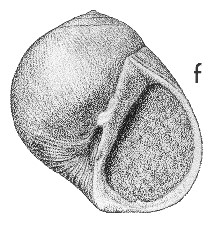
Revised descriptions of New Zealand Cenozoic Mollusca from Beu and Maxwell (1990)

 | Revised descriptions of New Zealand Cenozoic Mollusca from Beu and Maxwell (1990) | 
|
  (Pl. 15f): GS10837, I40/f001, head of Lake Waitaki, Duntroonian (GNS) |
Beu & Maxwell (1990): Chapter 10; p. 158; pl. 15 f.
Synonymy: Polinices planispirus Suter 1917, p. 10; Natica (Magnatica) suteri Marwick, 1924d, p. 555-556 (unnecessary name change for P. planispirus); Magnatica powelli Laws 1932, p. 190-191
Type species (as N. suteri) of Magnatica Marwick, 1924
Classification: Naticidae: Naticinae
Description: Large for family (height 40-65 mm), robust, ovate or globose; spire of variable height, considerably lower in many shells than in figured specimen. Protoconch not known, teleoconch whorls expanding very rapidly. No sculpture apart from growth lines and very tine spiral striae. Aperture large, semilunular; inner lip almost straight, heavily callused in parietal region, thickened abapically by low, rounded, circumumbilical ridge. Umbilicus of variable size, typically rather narrow but deep, with obscure grooves and ridges within. Outer lip sinuous, retracted to suture. Operculum large, ovate, rather thick.
Comparison: Magnatica planispira is a particularly common and conspicuous member of faunules in the Wharekuri Greensand at Lake Waitaki and the Otekaike Limestone at Trig Z, Otiake. M. powelli cannot satisfactorily be separated from M. planispira and is here regarded as a synonym. Three other nominal species of Magnatica (sensu stricto) have been described; M. approximata was based on very poor material from "Wharekuri" (probably Whaingaroan rather than Duntroonian) and may be another synonym of M. planispira. The poorly known M. fons (Bortonian, Waihao Downs) seems to have been considerably smaller than M. planispira (height of holotype only 22.5 mm) and has a sharper circumumbilical ridge. M. nuda (Tongaporutuan, North Taranaki) is even smaller (height of holotype 13 mm) and has a relatively wide umbilicus.
Marwick (1924d, p. 555) provided the replacement name Natica suteri for P. planispirus Suter, because of the prior Natica planispira Phillips, 1863. However, with recognition of Magnatica as a genus, Finlay (1927b, p. 500) reintroduced Suter's name, and this has certainly won general acceptance, so it remains available under ICZN Article 59.3.
Magnatica planispira is readily distinguished from most other New Zealand naticids by its large size, its thick shell, its typically globose shape with rapidly expanding whorls and short spire, and its laterally restricted parietal callus. Some species of the subgenus Magnatica (Spelaenacca) (see below) are superficially similar but differ in having a step-like ridge ascending well within the umbilicus. The distinctive large operculum is found within the aperture of a few specimens (Graham 1965).
Distribution: Duntroonian-Altonian; Mount Harris Formation, Bluecliffs, South Canterbury, Otaian (type locality of P. planispirus) (very rare); Ardgowan Shellbed, Oamaru, Altonian (type locality of M. powelli) (uncommon) and numerous localities throughout New Zealand, mostly in inner to mid-shelf facies, but apparently extending into deeper waters (outer shelf or upper slope).
Cite this publication as: "A.G. Beu and J.I. Raine (2009). Revised
descriptions of New Zealand Cenozoic Mollusca from Beu and Maxwell (1990). GNS
Science miscellaneous series no. 27."
© GNS Science, 2009
ISBN
978-0-478-19705-1
ISSN 1177-2441
(Included with a PDF facsimile file
copy of New Zealand Geological Survey Paleontological Bulletin 58 in CD version
from: Publications Officer, GNS Science, P.O. Box 30368 Lower Hutt, New
Zealand)